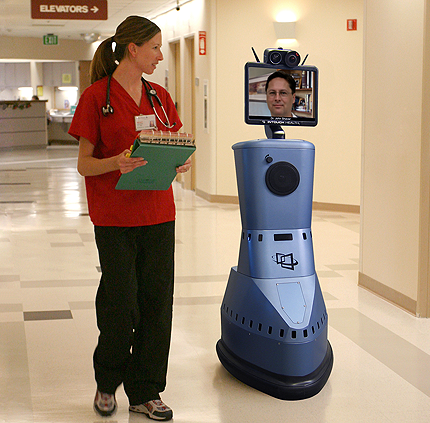What could make the difference between a stroke patient walking out of the hospital rather than being pushed in a wheelchair? Going back to work rather than going to rehab?
William was in his 70s. He had high blood pressure, but otherwise was in good health. One day last fall, he noticed his hand going numb and becoming progressively weaker. His speech was slurred. His wife called 911.
The faster you get to the hospital once stroke symptoms begin, the less likely you are to have any lasting effects. That’s what the doctors say and statistics bear out. “Time is brain” is the stroke-care mantra.
The Washington University stroke-care team at Barnes-Jewish Hospital is nationally known for excellence in treating stroke, and for researching and developing stroke protocols and treatments. But what if a stroke patient can’t easily get to Barnes-Jewish for treatment? Then the stroke-care team works with a network of smaller community hospitals throughout the region— making sure patients at those hospitals have access to the best stroke care available.
Currently, when a suspected stroke patient rolls into the emergency room at a network hospital, physicians there can phone the BJC Transfer Center at Barnes-Jewish and within minutes, consult directly with a Washington University stroke specialist. Alton Memorial Hospital in Alton, Ill., where William went for care, calls on the Washington University stroke-care team at Barnes-Jewish about five to 10 times a month, according to emergency medicine physician Rodger Hanko, MD, interim director of stroke care at Alton Memorial. Working with the stroke-care team allows the Alton doctors to offer patients advanced stroke care, even treatment with tPA—a clotbusting drug used to treat stroke—when appropriate.
“From my view, this relationship extends the expertise of the Washington University and Barnes- Jewish team further into the bi-state area and gives more community members access to quicker care and recovery,” Hanko says. “Ideally we evaluate patients quickly after stroke symptom onset, and communicate early with the Washington University team to begin treatment. We will work with the Washington University physicians as closely as needed, and keep regular communications going.”
Working with the Washington University stroke-care team, the Alton Memorial physicians administered tPA at their facility and then transferred William to Barnes-Jewish for further treatment and follow-up. As a result, he was able to walk out of the hospital several days later. Other than minor, occasional problems with his balance, he has no lasting effects of the stroke and has returned to a normal life.
“Barnes-Jewish Hospital is recognized as a national leader in stroke care. For years, our stroke network has helped patients who can’t get to Barnes-Jewish immediately to receive excellent, evidence-based stroke care,” says Renee Van Stavern, MD, co-director of the Washington University stroke-care team at Barnes-Jewish. Now, the team is strengthening the stroke network with innovations such as a telemedicine robot pilot program, Van Stavern says.
Robot enhances stroke network
In January, the stroke-care team placed a telemedicine robot in the emergency department at Parkland Health Center in Farmington, Mo., 60 miles south of St. Louis. Robots are currently used around the country to make specialist physicians “remotely present” in the patient’s room at distant hospitals.
“For acute stroke care, this may mean faster, more accurate onsite treatment to patients presenting to our partner hospitals,” says Peter Panagos, MD, co-director of the stroke-care team. “This can be especially critical at distant hospitals where transporting the patient to Barnes-Jewish could potentially put the patient outside of the window for treatment with tPA.”
“It takes about 20 minutes by air and an hour and 15 minutes by ambulance to get to Barnes-Jewish,” says John Hunt, MD, director of emergency medicine at Parkland. “That eats up valuable time.”
Parkland’s emergency room physicians are now the first in the network to work collaboratively through the stroke robot with the Washington University stroke neurologist. The InTouch robot at Parkland connects to Barnes-Jewish via wireless internet. The Washington University stroke expert at Barnes-Jewish is able to maneuver the robot, and a two-way audio/video feed allows the expert and patient to see and hear each other. This lets the stroke specialist conduct his or her own neurological examination and interact directly with the patient, family and local medical staff, Panagos says. In addition, the stroke expert receives real-time feeds of vital signs, test results and imaging.
“The robot is an effective tool in helping us collaborate with the Parkland emergency staff in getting patients diagnosed and appropriate treatment started as quickly as possible,” says Van Stavern. “This just enhances our relationship with Parkland and benefits patients in that area.”
